Employee & Labor Relations: Analyzing a Union Organizing Campaign
VerifiedAdded on 2023/04/25
|7
|1390
|246
Report
AI Summary
This report provides an overview of employee and labor relations during a union organizing campaign. It details the process by which private sector employees can petition the National Labor Relations Board (NLRB) to form a union, requiring support from at least 30% of fellow employees. It outlines the 'TIPS' rule, which specifies what employers cannot do (threats, interrogation, promises, surveillance) during a campaign, and the 'FOE' rule, which describes what employers can do (facts, opinions, examples) to communicate with employees without interfering with their right to choose. The report emphasizes the importance of employers providing accurate information to employees to enable informed decision-making regarding union representation. The document also contains references to relevant sources and websites.
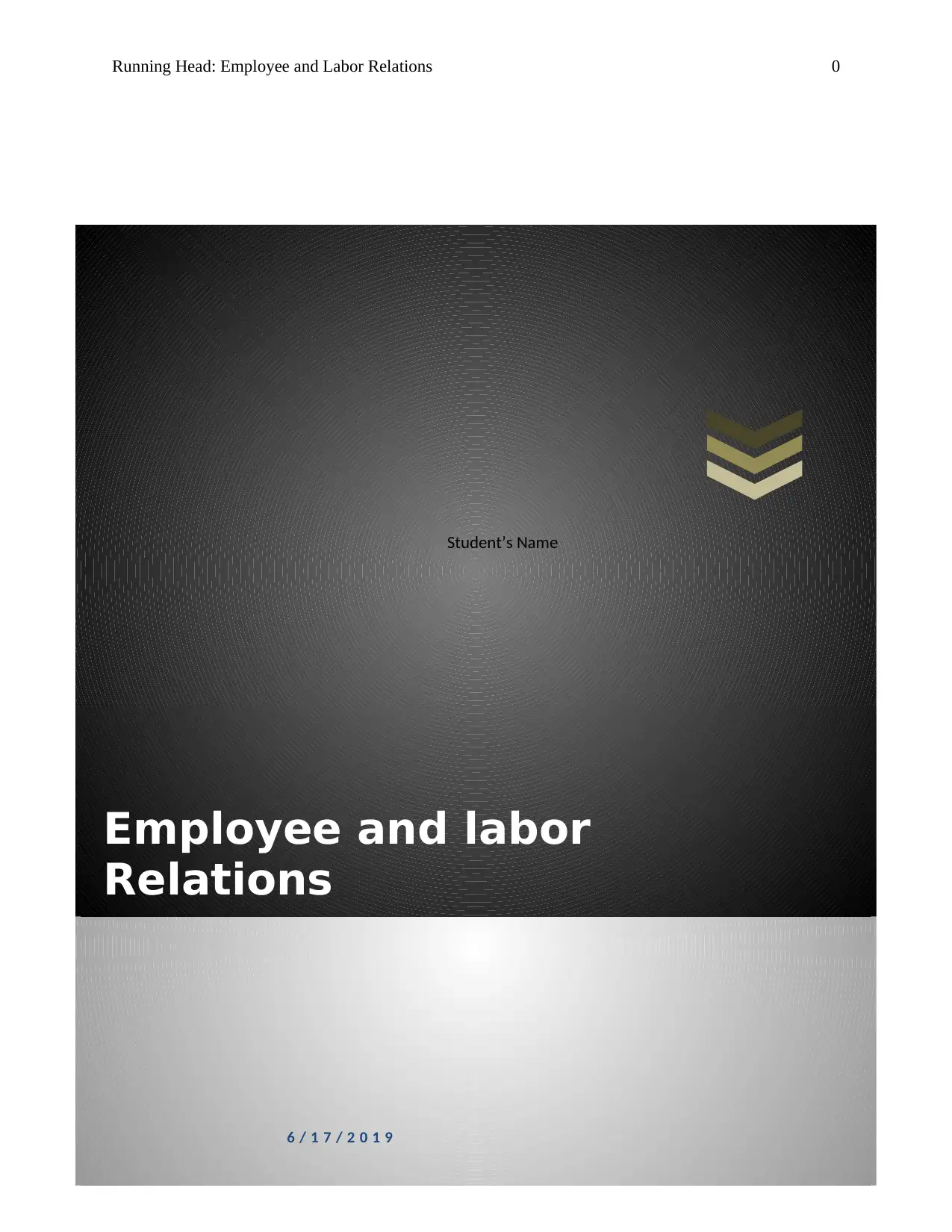
Employee and labor
Relations
Running Head: Employee and Labor Relations 0
6 / 1 7 / 2 0 1 9
Student’s Name
Relations
Running Head: Employee and Labor Relations 0
6 / 1 7 / 2 0 1 9
Student’s Name
Paraphrase This Document
Need a fresh take? Get an instant paraphrase of this document with our AI Paraphraser
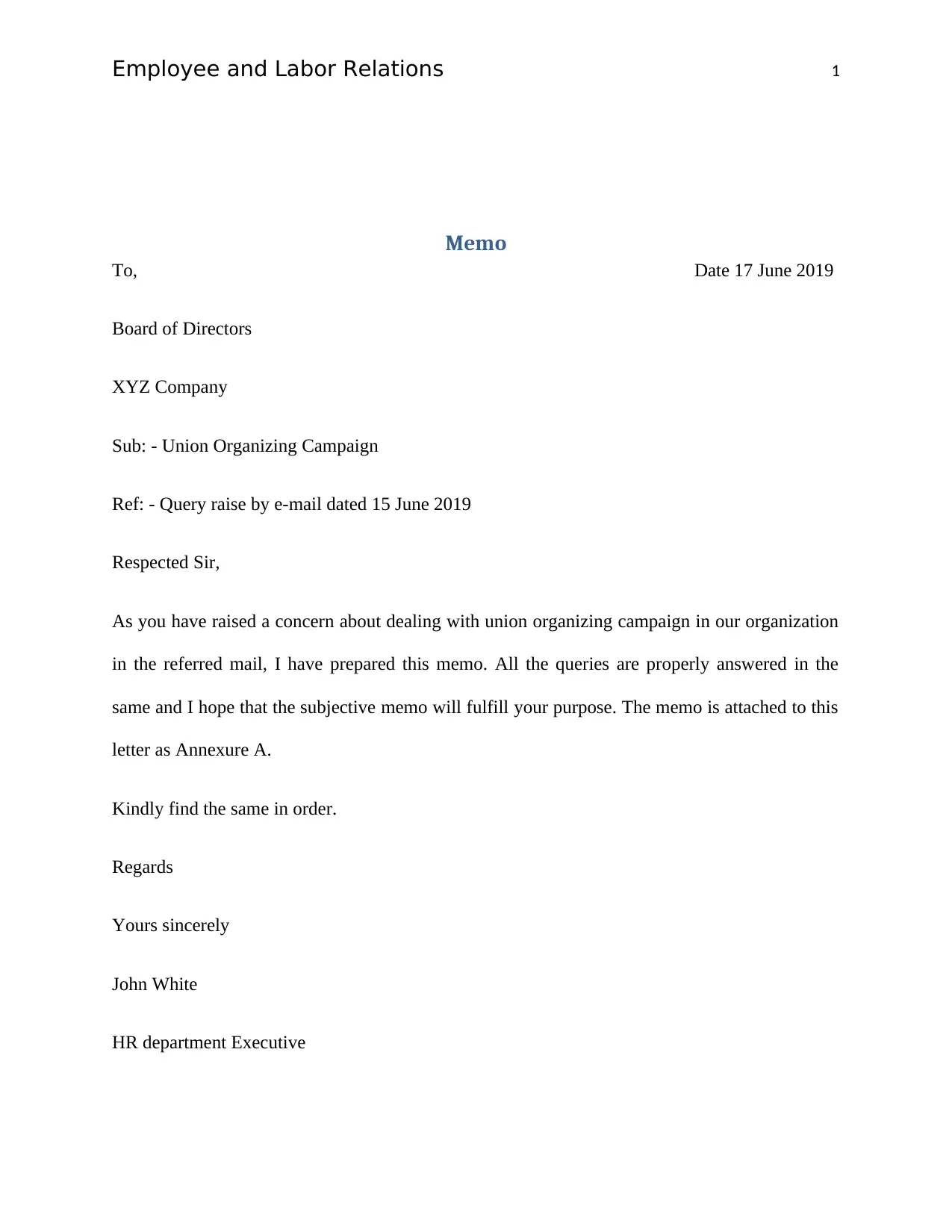
Employee and Labor Relations 1
Memo
To, Date 17 June 2019
Board of Directors
XYZ Company
Sub: - Union Organizing Campaign
Ref: - Query raise by e-mail dated 15 June 2019
Respected Sir,
As you have raised a concern about dealing with union organizing campaign in our organization
in the referred mail, I have prepared this memo. All the queries are properly answered in the
same and I hope that the subjective memo will fulfill your purpose. The memo is attached to this
letter as Annexure A.
Kindly find the same in order.
Regards
Yours sincerely
John White
HR department Executive
Memo
To, Date 17 June 2019
Board of Directors
XYZ Company
Sub: - Union Organizing Campaign
Ref: - Query raise by e-mail dated 15 June 2019
Respected Sir,
As you have raised a concern about dealing with union organizing campaign in our organization
in the referred mail, I have prepared this memo. All the queries are properly answered in the
same and I hope that the subjective memo will fulfill your purpose. The memo is attached to this
letter as Annexure A.
Kindly find the same in order.
Regards
Yours sincerely
John White
HR department Executive
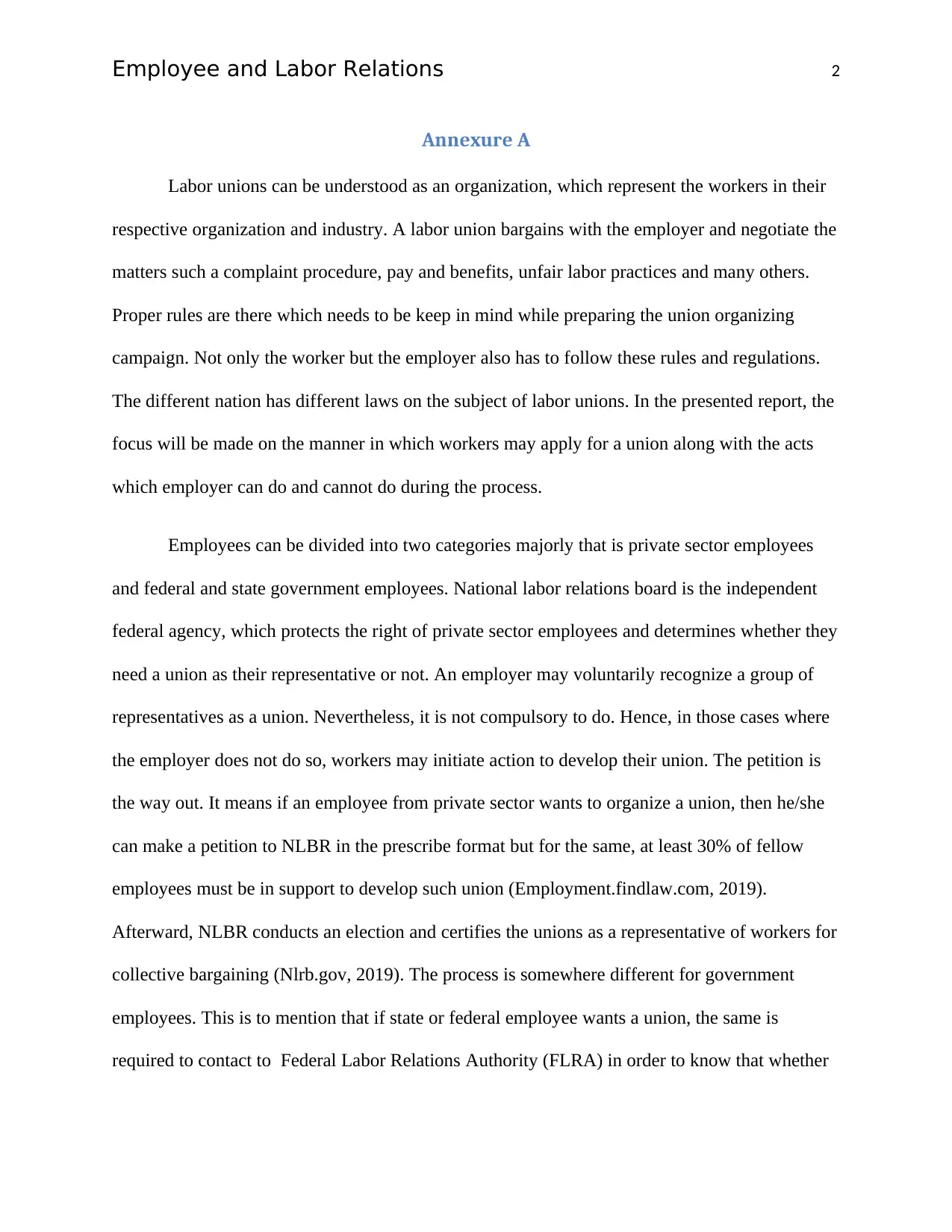
Employee and Labor Relations 2
Annexure A
Labor unions can be understood as an organization, which represent the workers in their
respective organization and industry. A labor union bargains with the employer and negotiate the
matters such a complaint procedure, pay and benefits, unfair labor practices and many others.
Proper rules are there which needs to be keep in mind while preparing the union organizing
campaign. Not only the worker but the employer also has to follow these rules and regulations.
The different nation has different laws on the subject of labor unions. In the presented report, the
focus will be made on the manner in which workers may apply for a union along with the acts
which employer can do and cannot do during the process.
Employees can be divided into two categories majorly that is private sector employees
and federal and state government employees. National labor relations board is the independent
federal agency, which protects the right of private sector employees and determines whether they
need a union as their representative or not. An employer may voluntarily recognize a group of
representatives as a union. Nevertheless, it is not compulsory to do. Hence, in those cases where
the employer does not do so, workers may initiate action to develop their union. The petition is
the way out. It means if an employee from private sector wants to organize a union, then he/she
can make a petition to NLBR in the prescribe format but for the same, at least 30% of fellow
employees must be in support to develop such union (Employment.findlaw.com, 2019).
Afterward, NLBR conducts an election and certifies the unions as a representative of workers for
collective bargaining (Nlrb.gov, 2019). The process is somewhere different for government
employees. This is to mention that if state or federal employee wants a union, the same is
required to contact to Federal Labor Relations Authority (FLRA) in order to know that whether
Annexure A
Labor unions can be understood as an organization, which represent the workers in their
respective organization and industry. A labor union bargains with the employer and negotiate the
matters such a complaint procedure, pay and benefits, unfair labor practices and many others.
Proper rules are there which needs to be keep in mind while preparing the union organizing
campaign. Not only the worker but the employer also has to follow these rules and regulations.
The different nation has different laws on the subject of labor unions. In the presented report, the
focus will be made on the manner in which workers may apply for a union along with the acts
which employer can do and cannot do during the process.
Employees can be divided into two categories majorly that is private sector employees
and federal and state government employees. National labor relations board is the independent
federal agency, which protects the right of private sector employees and determines whether they
need a union as their representative or not. An employer may voluntarily recognize a group of
representatives as a union. Nevertheless, it is not compulsory to do. Hence, in those cases where
the employer does not do so, workers may initiate action to develop their union. The petition is
the way out. It means if an employee from private sector wants to organize a union, then he/she
can make a petition to NLBR in the prescribe format but for the same, at least 30% of fellow
employees must be in support to develop such union (Employment.findlaw.com, 2019).
Afterward, NLBR conducts an election and certifies the unions as a representative of workers for
collective bargaining (Nlrb.gov, 2019). The process is somewhere different for government
employees. This is to mention that if state or federal employee wants a union, the same is
required to contact to Federal Labor Relations Authority (FLRA) in order to know that whether
⊘ This is a preview!⊘
Do you want full access?
Subscribe today to unlock all pages.

Trusted by 1+ million students worldwide
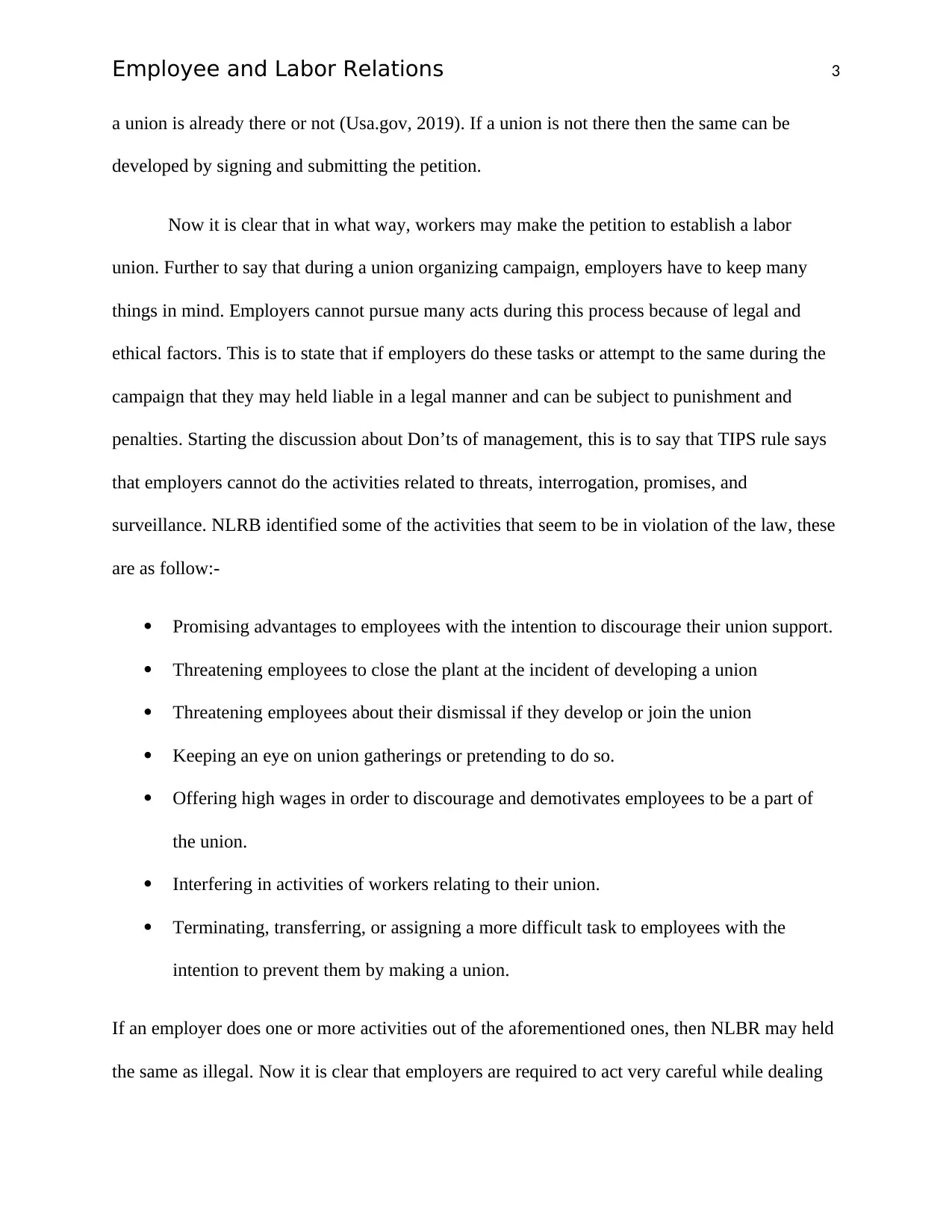
Employee and Labor Relations 3
a union is already there or not (Usa.gov, 2019). If a union is not there then the same can be
developed by signing and submitting the petition.
Now it is clear that in what way, workers may make the petition to establish a labor
union. Further to say that during a union organizing campaign, employers have to keep many
things in mind. Employers cannot pursue many acts during this process because of legal and
ethical factors. This is to state that if employers do these tasks or attempt to the same during the
campaign that they may held liable in a legal manner and can be subject to punishment and
penalties. Starting the discussion about Don’ts of management, this is to say that TIPS rule says
that employers cannot do the activities related to threats, interrogation, promises, and
surveillance. NLRB identified some of the activities that seem to be in violation of the law, these
are as follow:-
Promising advantages to employees with the intention to discourage their union support.
Threatening employees to close the plant at the incident of developing a union
Threatening employees about their dismissal if they develop or join the union
Keeping an eye on union gatherings or pretending to do so.
Offering high wages in order to discourage and demotivates employees to be a part of
the union.
Interfering in activities of workers relating to their union.
Terminating, transferring, or assigning a more difficult task to employees with the
intention to prevent them by making a union.
If an employer does one or more activities out of the aforementioned ones, then NLBR may held
the same as illegal. Now it is clear that employers are required to act very careful while dealing
a union is already there or not (Usa.gov, 2019). If a union is not there then the same can be
developed by signing and submitting the petition.
Now it is clear that in what way, workers may make the petition to establish a labor
union. Further to say that during a union organizing campaign, employers have to keep many
things in mind. Employers cannot pursue many acts during this process because of legal and
ethical factors. This is to state that if employers do these tasks or attempt to the same during the
campaign that they may held liable in a legal manner and can be subject to punishment and
penalties. Starting the discussion about Don’ts of management, this is to say that TIPS rule says
that employers cannot do the activities related to threats, interrogation, promises, and
surveillance. NLRB identified some of the activities that seem to be in violation of the law, these
are as follow:-
Promising advantages to employees with the intention to discourage their union support.
Threatening employees to close the plant at the incident of developing a union
Threatening employees about their dismissal if they develop or join the union
Keeping an eye on union gatherings or pretending to do so.
Offering high wages in order to discourage and demotivates employees to be a part of
the union.
Interfering in activities of workers relating to their union.
Terminating, transferring, or assigning a more difficult task to employees with the
intention to prevent them by making a union.
If an employer does one or more activities out of the aforementioned ones, then NLBR may held
the same as illegal. Now it is clear that employers are required to act very careful while dealing
Paraphrase This Document
Need a fresh take? Get an instant paraphrase of this document with our AI Paraphraser
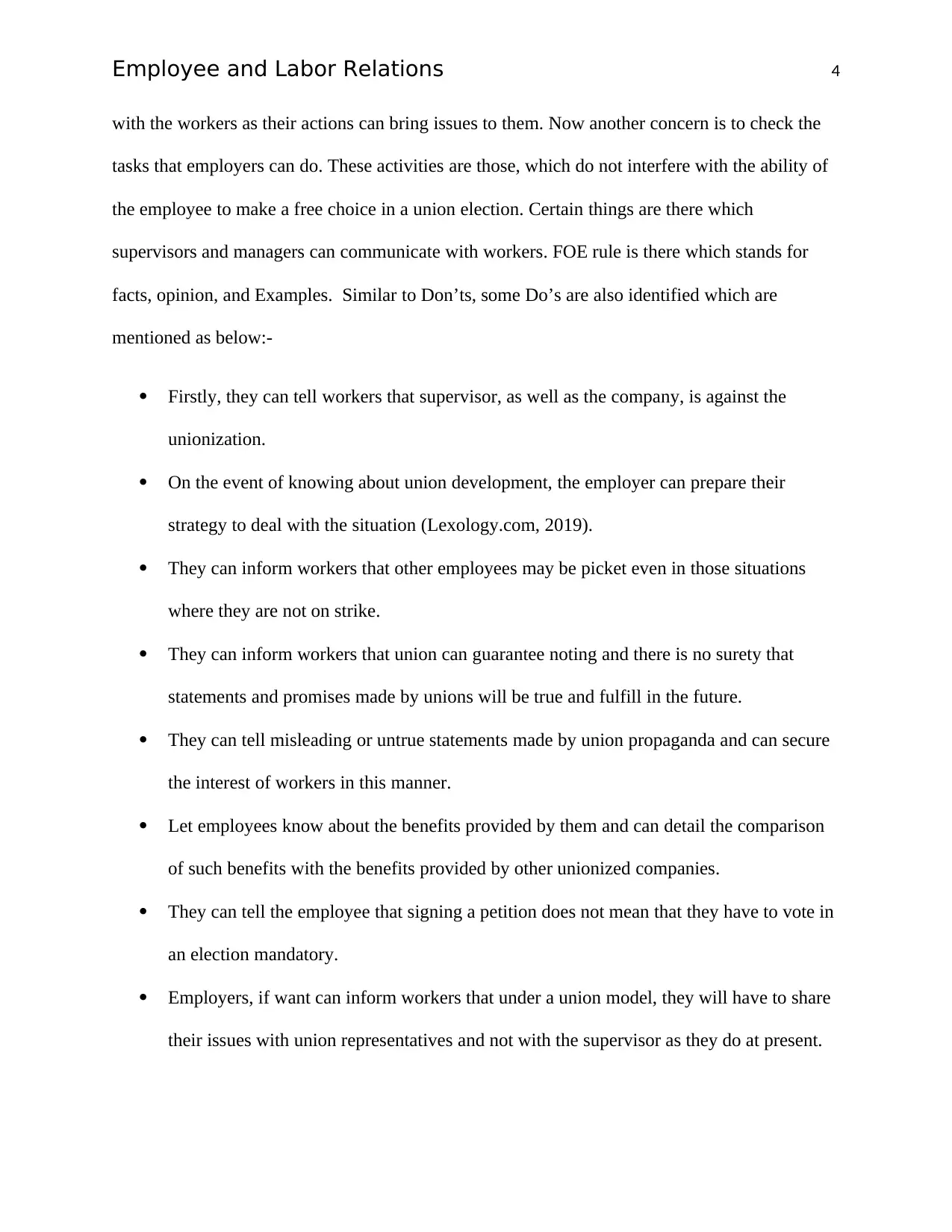
Employee and Labor Relations 4
with the workers as their actions can bring issues to them. Now another concern is to check the
tasks that employers can do. These activities are those, which do not interfere with the ability of
the employee to make a free choice in a union election. Certain things are there which
supervisors and managers can communicate with workers. FOE rule is there which stands for
facts, opinion, and Examples. Similar to Don’ts, some Do’s are also identified which are
mentioned as below:-
Firstly, they can tell workers that supervisor, as well as the company, is against the
unionization.
On the event of knowing about union development, the employer can prepare their
strategy to deal with the situation (Lexology.com, 2019).
They can inform workers that other employees may be picket even in those situations
where they are not on strike.
They can inform workers that union can guarantee noting and there is no surety that
statements and promises made by unions will be true and fulfill in the future.
They can tell misleading or untrue statements made by union propaganda and can secure
the interest of workers in this manner.
Let employees know about the benefits provided by them and can detail the comparison
of such benefits with the benefits provided by other unionized companies.
They can tell the employee that signing a petition does not mean that they have to vote in
an election mandatory.
Employers, if want can inform workers that under a union model, they will have to share
their issues with union representatives and not with the supervisor as they do at present.
with the workers as their actions can bring issues to them. Now another concern is to check the
tasks that employers can do. These activities are those, which do not interfere with the ability of
the employee to make a free choice in a union election. Certain things are there which
supervisors and managers can communicate with workers. FOE rule is there which stands for
facts, opinion, and Examples. Similar to Don’ts, some Do’s are also identified which are
mentioned as below:-
Firstly, they can tell workers that supervisor, as well as the company, is against the
unionization.
On the event of knowing about union development, the employer can prepare their
strategy to deal with the situation (Lexology.com, 2019).
They can inform workers that other employees may be picket even in those situations
where they are not on strike.
They can inform workers that union can guarantee noting and there is no surety that
statements and promises made by unions will be true and fulfill in the future.
They can tell misleading or untrue statements made by union propaganda and can secure
the interest of workers in this manner.
Let employees know about the benefits provided by them and can detail the comparison
of such benefits with the benefits provided by other unionized companies.
They can tell the employee that signing a petition does not mean that they have to vote in
an election mandatory.
Employers, if want can inform workers that under a union model, they will have to share
their issues with union representatives and not with the supervisor as they do at present.
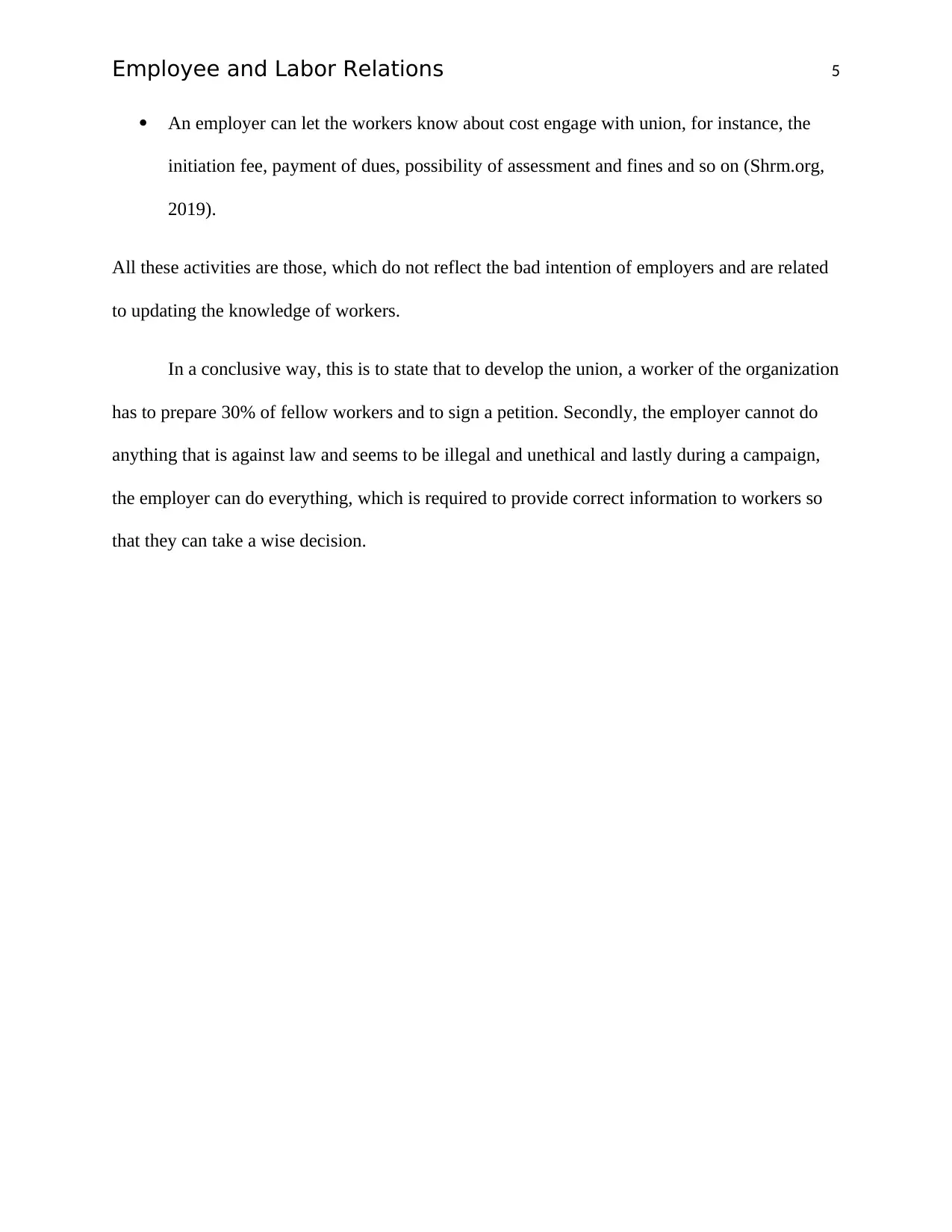
Employee and Labor Relations 5
An employer can let the workers know about cost engage with union, for instance, the
initiation fee, payment of dues, possibility of assessment and fines and so on (Shrm.org,
2019).
All these activities are those, which do not reflect the bad intention of employers and are related
to updating the knowledge of workers.
In a conclusive way, this is to state that to develop the union, a worker of the organization
has to prepare 30% of fellow workers and to sign a petition. Secondly, the employer cannot do
anything that is against law and seems to be illegal and unethical and lastly during a campaign,
the employer can do everything, which is required to provide correct information to workers so
that they can take a wise decision.
An employer can let the workers know about cost engage with union, for instance, the
initiation fee, payment of dues, possibility of assessment and fines and so on (Shrm.org,
2019).
All these activities are those, which do not reflect the bad intention of employers and are related
to updating the knowledge of workers.
In a conclusive way, this is to state that to develop the union, a worker of the organization
has to prepare 30% of fellow workers and to sign a petition. Secondly, the employer cannot do
anything that is against law and seems to be illegal and unethical and lastly during a campaign,
the employer can do everything, which is required to provide correct information to workers so
that they can take a wise decision.
⊘ This is a preview!⊘
Do you want full access?
Subscribe today to unlock all pages.

Trusted by 1+ million students worldwide

Employee and Labor Relations 6
References
Employment.findlaw.com. (2019). How to Switch Labor Unions. Retrieved From:
https://employment.findlaw.com/wages-and-benefits/how-to-switch-labor-unions.html
Lexology.com. (2019). What To Do (And Not Do) When A Union Campaign Hits. Retrieved
From: https://www.lexology.com/library/detail.aspx?g=60463840-a2e4-4523-a7a9-
1a7f262523d4
Nlrb.gov. (2019). Your Right to Form a Union. Retrieved From: https://www.nlrb.gov/rights-we-
protect/whats-law/employees/i-am-not-represented-union/your-right-form-union
Shrm.org. (2019). What can management do during a union campaign? Retrieved From:
https://www.shrm.org/resourcesandtools/tools-and-samples/hr-qa/pages/
unioncampaigns.aspx
Usa.gov. (2019). Labor Laws and Issues. Retrieved From: https://www.usa.gov/labor-laws#item-
34972
References
Employment.findlaw.com. (2019). How to Switch Labor Unions. Retrieved From:
https://employment.findlaw.com/wages-and-benefits/how-to-switch-labor-unions.html
Lexology.com. (2019). What To Do (And Not Do) When A Union Campaign Hits. Retrieved
From: https://www.lexology.com/library/detail.aspx?g=60463840-a2e4-4523-a7a9-
1a7f262523d4
Nlrb.gov. (2019). Your Right to Form a Union. Retrieved From: https://www.nlrb.gov/rights-we-
protect/whats-law/employees/i-am-not-represented-union/your-right-form-union
Shrm.org. (2019). What can management do during a union campaign? Retrieved From:
https://www.shrm.org/resourcesandtools/tools-and-samples/hr-qa/pages/
unioncampaigns.aspx
Usa.gov. (2019). Labor Laws and Issues. Retrieved From: https://www.usa.gov/labor-laws#item-
34972
1 out of 7
Related Documents
Your All-in-One AI-Powered Toolkit for Academic Success.
+13062052269
info@desklib.com
Available 24*7 on WhatsApp / Email
![[object Object]](/_next/static/media/star-bottom.7253800d.svg)
Unlock your academic potential
Copyright © 2020–2025 A2Z Services. All Rights Reserved. Developed and managed by ZUCOL.





